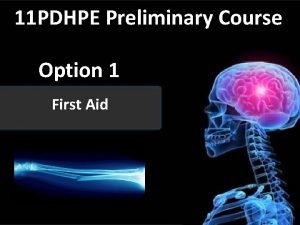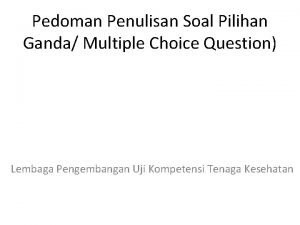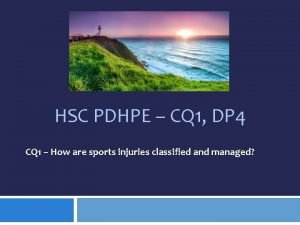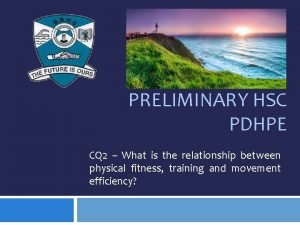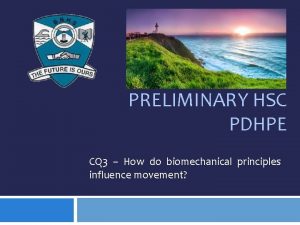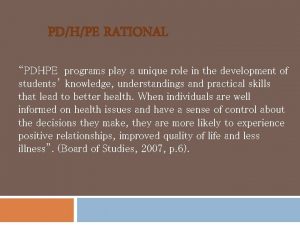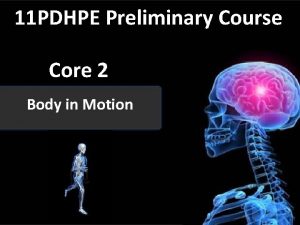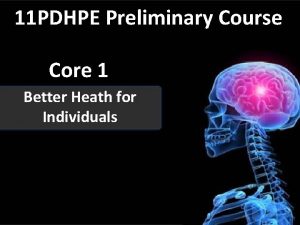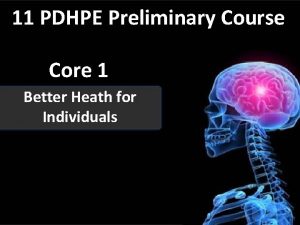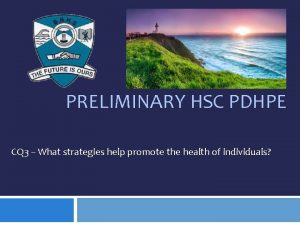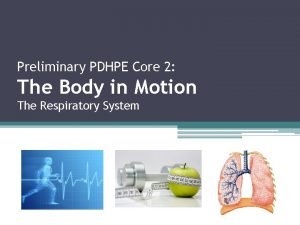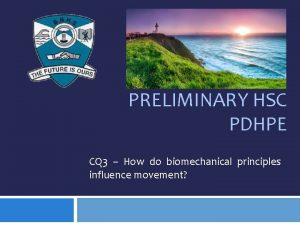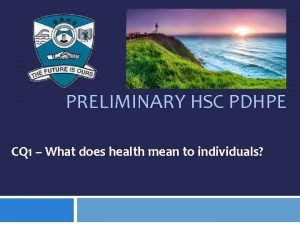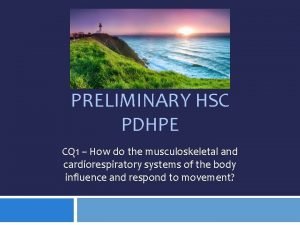11 PDHPE Preliminary Course Option 1 Focus Question















- Slides: 15

11 PDHPE Preliminary Course Option 1: Focus Question 3 What does the individual need to consider in administering first aid?

The nature of the physical environment may, in part, have been responsible for the occurrence of the accident in the first place. For example, a drowning may have occurred because of rapidly rising water. Whatever the circumstances, it is important that protective measures be observed and strategies put into place so that a further injury does not occur. The following slides outline action plans for first aid scenarios in an open environment.

In the case of traffic accidents, the rescuer must be aware of the potential danger from: • oncoming traffic • fallen electricity wires • flammable liquids such as LPG, gas and petrol • glass and debris • fire. Protective strategies that the rescuer needs to observe include: • providing a protective barrier by parking a vehicle between the oncoming traffic and the accident • turning hazard lights on • placing a warning signal or sending a person back up the road to warn traffic • turning the ignition off if the engine is still running • lighting the area with low beam if the accident has occurred at night to raise awareness and increase safety. When the rescuer has followed the protective strategies, they can: • call for or send for help • assess the number of casualties and potential dangers. If fallen electricity wires are in contact with the vehicle, the vehicle must not be touched as electrocution may occur. • implement the DRABCD procedures

Do not remove the casualty unless one or a number of the following conditions is present: 1. there is evidence of increasing shock and the casualty is upright in the car 2. the casualty is unconscious and an adequate airway cannot be maintained 3. the casualty’s position prevents access to control bleeding 4. there is danger of fire.

The water environment can disguise particular problems. The rescuer must be aware of: their own physical limitations, such as: • their ability to swim • the desperation of a drowning person and their potential to cause difficulty to the rescuer • hazardous objects under the water and not visible to the observer • dangerous rips and currents • changes in weather conditions • water temperature. Protective strategies that need to be used include • sending for help immediately • not placing yourself at risk if you are not sure that you can perform the rescue safely • using ropes, branches and flotation devices where possible • entering unknown waters carefully.

Electricity has an immense potential for danger because it is not visible. We know it is in electrical wires. When the wires are exposed through circumstances such as frayed or cut electrical insulation or fallen power lines, electricity is conducted through any metallic material that is in contact with the wires. By touching the conducting material, such as a car body, electrocution occurs. The voltage in most wires is sufficient to cause severe burns and instant death. The rescuer needs to: • be aware of the deadly nature of electricity and how it is conducted • examine the situation and assess the potential for harm. Protective strategies include • not touching cars or objects that are in contact with fallen power lines • turning the power off at the source (light switch or main switch) in the case of a domestic accident • removing live power cords with nonconducting material such as a stick if the power cannot be turned off immediately.

There is a risk of cross-infection (passing infection from one person to another) when administering first aid. This is particularly so when giving CPR or managing wounds. Illnesses that can be transferred include: • colds and influenza • HIV/AIDS • glandular fever • measles • chickenpox • mumps • herpes • hepatitis. Administration of first aid requires that measures be taken to avoid transmission of infection under any circumstances. The first aider must use hygienic practices and create a barrier so that the infection cannot pass from one person to another. The situations that cause most concern are in relation to HIV/AIDS infection and blood-borne viruses such as hepatitis B and C.

The HIV virus (human immunodeficiency virus) that causes AIDS can be transmitted only through the exchange of blood and, in some cases, body fluids, from an infected to a non-infected person. Highest concentrations of the HIV virus are in blood. To pass the virus from one person to another during first aid, both the casualty and the rescuer need to have cuts or wounds that are open and the blood of the infected person needs to mix with the blood of the non-infected person. This situation, although possible, is highly unlikely. It is important to realise that this type of infection must pass from the bloodstream of one person and into the bloodstream of another for transmission to take place. Although HIV exists in saliva, the quantity exchanged during CPR would not be sufficient for effective transmission and, in any case, the virus would be destroyed by the stomach juices.

To prevent transmission, the first aider needs to implement appropriate management strategies that prevent any possibility of viral transfer. The simplest way is to assume that every casualty is infected and take the following precautions: • use disposable plastic gloves • cover sores, grazes, cuts, abrasions or incisions of any nature that exposes anyone’s blood • cover the face of an unconscious person with a face • mask before administering CPR • wash hands and any surfaces of the body that have made contact with the casualty with soap and warm water as soon as possible following treatment.

Research the following illnesses, describe illness and devise a safety action plan for treating casualties to prevent cross-infection. Illness Hepatitis B & C Glandular Fever Measles Short description of illness & risk factors Safety plan for treatment

The legal implications of providing emergency care often a cause of concern for many people. According to the Royal Life Saving Society Australia (RLSSA) (op. cit. , p. 11), a first aider could be expected to: • use reasonable care in assessing the priorities of the situation based on their level of training • take steps to call for further medical assistance • keep the casualty stabilised until medical assistance arrives • follow established treatment and management protocols • not misrepresent themselves or take unnecessary risks. The RLSSA further suggests that each individual needs to use commonsense and act in accordance with their level of training should situations requiring first aid arise. Even though you may be saving someone’s life, as a first aider you could be sued in court or questioned over your duty of care to a patient.

In emergency situations there exists a certain moral responsibility to act in accordance with your training and provide assistance to the injured or distressed. It would be considered a responsible action to help people involved in an accident. It would be irresponsible not to help people unable to help themselves. Fortunately we are not frequently tested with these situations to see just how we would respond. In many cases, the emergency first aid required is for a family member and we react instinctively. But what would we do if we came across a road accident where none of the victims were known to us? Responsible citizenship suggests that we should help and provide assistance to the best of our ability.

Basic first aid training reinforces the principles of commonsense and the prevention of further injury. The first principle of the DRABCD action plan is to remove the danger from the patient or the patient from the danger so that there is no further injury and possible loss of life. There may be some risk involved, but a rescue action does not call for heroics. Using commonsense is absolutely essential in rescues and requires that the rescuer is able to think clearly, plan thoughtfully and act wisely.

Debriefing involves obtaining information about the circumstances of the incident that resulted in first aid being administered. The rescuer or rescuers may be required to give an account of what happened and describe as precisely as possible the nature of the incident. Police officers, ambulance officers or accident investigation personnel may make these inquiries. During debriefing, it is important to: • take the time to ensure that the full picture is gathered • make all descriptions as accurate as possible • remain impartial and describe the incident exactly as it occurred.

Rescuers involved in emergency procedures where there were fatalities and serious injuries (for example, spinal injuries or amputations) may need counselling. Providing emergency care, organising help and possibly watching life slip away can be very upsetting for individuals and result in personal pain. This can lead to anxiety, depression and possibly an inability to cope. Where this is evident, individuals should seek or be advised to seek help. Help is available from various counselling organisations including hospitals, medical support centres and State government organisations such as NSW Health. Counselling is beneficial as it provides the opportunity to ‘work through’ situations and dispel feelings of blame and inadequacy. Emergency first aid may provide an opportunity for a life or lives to be saved. However, if life is lost, rescuers should not feel that the blame rests with them if they acted in accordance with their training and ability level.
 Preliminary first aid
Preliminary first aid Konvergensi option adalah
Konvergensi option adalah Option a option b
Option a option b Costas higher level questions
Costas higher level questions Actor focus vs object focus
Actor focus vs object focus Language
Language Porter's generic strategies
Porter's generic strategies Timex cost leadership strategy
Timex cost leadership strategy Qft technique
Qft technique Cara shank
Cara shank What is focus question
What is focus question Graduated exercise pdhpe
Graduated exercise pdhpe Totaps procedure
Totaps procedure Kinaesthetic sense pdhpe
Kinaesthetic sense pdhpe Hsc pdhpe
Hsc pdhpe Angular motion pdhpe
Angular motion pdhpe
